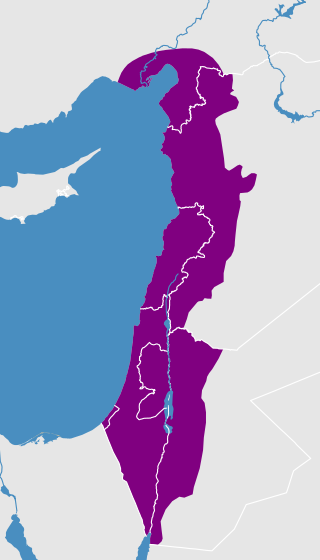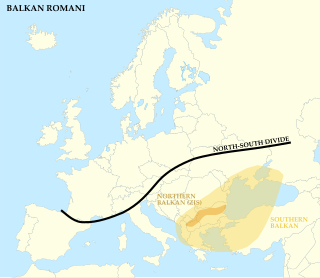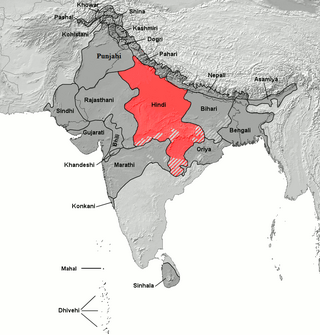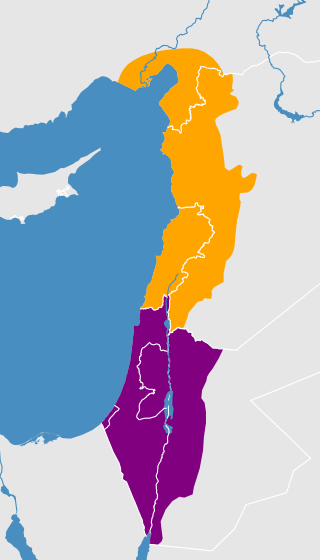
The Romani, also spelled Romany or Rromani and colloquially known as the Roma, are an ethnic group of Indo-Aryan origin who traditionally lived a nomadic, itinerant lifestyle. Linguistic and genetic evidence suggests that the Romani originated in the Indian subcontinent, in particular the region of present-day Rajasthan. Their subsequent westward migration, possibly in waves, is now believed by historians to have occurred around 1000 CE. Their original name is from the Sanskrit word डोम, doma and means a member of the Dom caste of travelling musicians and dancers. The Roma population moved west into the Ghaznavid Empire and later into the Byzantine Empire. The Roma are thought to have arrived in Europe around the 13th to 14th century. Although they are widely dispersed, their most concentrated populations are located in Bulgaria, Hungary, Romania, Spain, and Turkey.

The Indo-Aryan languages are a branch of the Indo-Iranian languages in the Indo-European language family. As of the early 21st century, they have more than 800 million speakers, primarily concentrated in India, Pakistan, Sri Lanka, Bangladesh, Nepal and Maldives. Moreover, apart from the Indian subcontinent, large immigrant and expatriate Indo-Aryan–speaking communities live in Northwestern Europe, Western Asia, North America, the Caribbean, Southeast Africa, Polynesia and Australia, along with several million speakers of Romani languages primarily concentrated in Southeastern Europe. There are over 200 known Indo-Aryan languages.
Romani is an Indo-Aryan macrolanguage of the Romani communities. According to Ethnologue, seven varieties of Romani are divergent enough to be considered languages of their own. The largest of these are Vlax Romani, Balkan Romani (600,000), and Sinte Romani (300,000). Some Romani communities speak mixed languages based on the surrounding language with retained Romani-derived vocabulary – these are known by linguists as Para-Romani varieties, rather than dialects of the Romani language itself.

The Sinti are a subgroup of Romani people. They are found mostly in Germany, France and Italy and Central Europe, numbering some 200,000 people. They were traditionally itinerant, but today only a small percentage of Sinti remain unsettled. In earlier times, they frequently lived on the outskirts of communities.
The Dom are descendants of the Dom caste with origins in the Indian subcontinent which through ancient migrations are found scattered across the Middle East and North Africa, the Eastern Anatolia Region, and parts of the Balkans and Hungary. The traditional language of the Dom is Domari, an endangered Indo-Aryan language, thereby making the Dom an Indo-Aryan ethnic group.

Levantine Arabic, also called Shami, is an Arabic variety spoken in the Levant, namely in Syria, Jordan, Lebanon, Palestine, Israel and southern Turkey. With over 54 million speakers, Levantine is, alongside Egyptian, one of the two prestige varieties of spoken Arabic comprehensible all over the Arab world.
Baltic Romani is group of dialects of the Romani language spoken in the Baltic states and adjoining regions of Poland and Russia. Half of the speakers live in Poland. It also called Balt Romani, Balt Slavic Romani, Baltic Slavic Romani, and Roma. Romani began as an Indo-European language, which morphed into an Indo-Iranian language, and then into an Indo-Aryan language. After that the Romani language broke down into Balkan Romani and Central Romani. Baltic Romani came from the Central Romani dialect which branches off into other dialects. There are a total of around 31,500 users in all countries.
Yaron Matras is a linguist at the University of Manchester specializing in Romani and other languages, including Middle Eastern languages. He is one of the most prominent English-language Romani linguists and the author of several pioneering studies, including a book on Romani: A Linguistic Introduction and on Romani in Britain: The afterlife of a language, and A Grammar of Domari. Matras organized the First International Conference on Romani Linguistics in 1993, and has served as Editor of the cross-disciplinary journal Romani Studies since 1999. He has coordinated the Romani Project at the University of Manchester since 1999, and in 2010 he launched the Multilingual Manchester project. His publications include a book on Language Contact and a co-edited trilogy on Mixed Languages, Linguistic Areas, and Grammatical Borrowing.
Nawar is an Arabic term for several nomad communities used primarily in Jordan, Syria, Lebanon, and Palestine. The term, regarded as derogatory, is used by Arabs for several diverse ethnic groups. They have historically been called "Gypsies", though as a whole they are not Romani per se. The Dom people are especially known as Nawar. While both they and Romani people originated from India, they came from two drastically different ethnicities and cultures.

Balkan Roma, Balkaniko Romanes, or Balkan Gypsy is a specific non-Vlax dialect of the Romani language, spoken by groups within the Balkans, which include countries such as Albania, Bosnia-Herzegovina, Bulgaria, Greece, Kosovo, North Macedonia, Serbia, Slovenia, Turkey etc. The Balkan Romani language is typically an oral language.

The Central Indo-Aryan languages or Hindi languages are a group of Indo-Aryan languages spoken across Northern and Central India. These language varieties form the central part of the Indo-Aryan language family, itself a part of the Indo-European language family. They historically form a dialect continuum that descends from the Middle Prakrits. Located in the Hindi Belt, the Central Zone includes the Dehlavi (Delhi) dialect of the Hindustani language, the lingua franca of Northern India that is the basis of the Modern Standard Hindi and Modern Standard Urdu literary standards. In regards to the Indo-Aryan language family, the coherence of this language group depends on the classification being used; here only Eastern and Western Hindi languages will be considered.

Jordanian Arabic is a dialect continuum of mutually intelligible varieties of Arabic spoken by the population of the Hashemite Kingdom of Jordan.

Carpathian Romani, also known as Central Romani or Romungro Romani, is a group of dialects of the Romani language spoken from southern Poland to Hungary, and from eastern Austria to Ukraine.

Palestinian Arabic is a dialect continuum of mutually intelligible varieties of Levantine Arabic spoken by most Palestinians in Palestine, Israel and in the Palestinian diaspora.
The Domari-speaking community in Syria, commonly identified as Dom and Nawar, is estimated to number 100–250,000 or 250–300,000 people. The vast majority is sedentary. There are semi-nomadic groups, some moving outside the country. In Aleppo, the Dom community is probably the largest, while they are reported to live in Damascus, Homs and Latakia as well. The community is highly marginalised in society, and they are referred to as Qurbāṭ and Qarač in the northern part, and Nawar elsewhere. These terms are used for various groups that mainly share socio-economic profile. The community is divided into clans.
The Dom or Ghagar people migrated to the territory of the present day Egypt from South Asia, particularly from Indian Subcontinent, and heavily intermixed with Egyptians. Scholars suggest that their Egyptian admixture later made them known around the world by the vernacular term Gypsies, deriving from the word "Egyptian." Though some of the Dom people self-segregated themselves for centuries from the dominant culture of Egypt, historically; Domari in Egypt have intermixed with Egyptians and participated at local musical entertainment at weddings, circumcisions and other celebrations, singing Egyptian traditional songs and dance in return for money. The Dom people in Egypt or Roma Egyptians include subgroups like Nawar, and Ghagar (ghaggar). The Dom in Egypt are Sunni Muslims and speak Egyptian Arabic also their own Domari language together.
Doms in Sudan speak the Domari language. They immigrated to the territory of the present day Sudan from South Asia, particularly from India, in Byzantine times. Dom and Nawar people self-segregated themselves for centuries from the dominant culture of Sudan, who view Romani as dishonorable though clever. Historically, Gypsies in Sudan have provided musical entertainment as weddings and other celebrations. The Romani people or Gypsies in Sudan include subgroups like Nawar, Halebi and Ghagar.
Doms in Tunisia speak the Domari language. They immigrated to the territory of the present day Tunisia from South Asia, particularly from India, in Byzantine times. Dom and Nawar people self-segregated themselves for centuries from the dominant culture of Tunisia, who view Romani as dishonorable though clever. Historically, Gypsies in Tunisia have provided musical entertainment as weddings and other celebrations. The Romani people or Gypsies in Tunisia include subgroups like Nawar, Halebi and Ghagar.
Early Romani is the latest common predecessor of all forms of the Romani language. It was spoken before the Roma people dispersed throughout Europe. It is not directly attested, but rather reconstructed on the basis of shared features of existing Romani varieties. Early Romani is thought to have been spoken in the Byzantine Empire between the 9th-10th and 13th-14th centuries.

There is a Dom community in Israel. It is estimated that about 5,000 Dom live in Israel, the West Bank and Gaza. Invisible to most Jerusalemites, between 1,200 and 3,000 of Dom reside inside the Lion's Gate, in and around Burj Laklak Street. The Dom population in Israel have dwindled over the years because many fled to Jordan during Israel's wars, particularly the Six-Day War in 1967. Israeli Doms are concentrated in Jerusalem and in the West Bank and Gaza. They are integrated into Muslim Palestinian society and are regarded by Israeli authorities as an integral part of the Arab population of East Jerusalem and the West Bank, internationally recognized as the occupied Palestinian territories.











